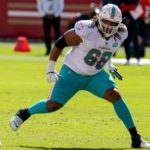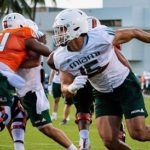Screen Pass: Phins Early Fail, Late Success …Why?

For most of our season, the screen pass was disastrous
Gase called the screen pass only 29 times this past season. Just EIGHT of those 29 attempts produced any worthwhile results …less than 28%. Think about that. Our 2017 QB, Jay Cutler, had an overall pass completion record of 62%. Why were the screen pass results so much worse? Admittedly, it felt like far worse than even that to suffering phins fans. While just one among many issues that plagued us, it’s well worth looking at why this offensive staple failed so often.
PhinsNews used a very cool channel on You Tube called Yung Mayo to take an in-depth look at virtually every screen pass the Dolphins threw in 2017. While certainly frustrating for a Phins fan to watch, there were some choice nuggets to be gleaned: how crucial play design is and how film study helps a defense destroy a play.
(Side Note: Every true Phins fan should check out Yung Mayo’s very cool channel on You Tube. Its a compilation of video studies of many aspects of the Phin’s past season)
Here’s the screen pass break down by game:
- Chargers: (5) moderately successful
- Jets: (2) zero success
- Saints: (4) negative yards and a turnover
- Titans: (2) negative yards
- Falcons: (1) minimal success
- Jets: none
- Ravens: (1) negative yards
- Raiders: (3) minimal success
- Panthers: (2) minimal success
- Tampa: (2) turnover
- Patriots: none
- Broncos: (1) moderate success, 1st down
- Patriots: none
- Bills: (2) minimal success
- Chiefs: (3) big gains, TD
- Bills: (1) good gain, 1st Down
Total: 29 screen passes, only 8 of which were true successes
First, it’s obvious that Grant had by far the most success running the screen play. But since he was stopped dead in his tracks against the Titans, it’s not just matter of his speed and agility being the defining factor. Of course it doesn’t hurt it either.
All the way up to the Chiefs game, the play design for the WR Screen (over and over again) was a naked screen (no play fake) or a half-hearted play fake to the RB inside.
Screen Pass Worked if the Opponent had no Tape to Study
Only the Opening Day game against the Chargers had any real success running this play. It’s reasonable to believe that was because there wasn’t any tape for the Charger’s defense to watch. Henceforth, the keys were there for defenses to pick up in film study. Compounding the problem, Gase added only superficial, if any, wrinkles. The best pay per head sites.
…Until Week 16. And then things changed.
The first screen in the Chiefs game added a play fake in a sweep to the WR with Grant alone on the opposite side. First, Grant’s speed threatens the top of the defense, so the CB is forced to drop deep and fast. That creates the kind of space that makes a screen thrive. Also, Grant has special fast-twitch suddenness. It gives him the ability to stop, come back, and catch as the blockers get out in front, and then accelerate all on a dime. Second, Landry and Drake are the decoys, along with all the motion going in the opposite direction. With both Miami’s top play makers moving to one side, the defense must respect the motion…
…But, the main ingredient here is that there wasn’t any tape of this play, so the defense had no keys.
Surprise! …Touch Down!
On the second screen, they have traps with Grant wide and Drake as the lone back. Again, Grant presses the deep route, and the CB must drop hard and fast. Meanwhile, Drake is given a play fake in a sweep to the opposite side. As the video clearly shows, his speed forces the LB’s to pause a beat. As a result, Grant’s acceleration gets him out of the hole and past the first down marker… and a broken tackle earns him the TD.
In the prior incarnations of this play with Landry and Ajayi, their speed (or lack thereof) didn’t offer the threat that Grant’s and Drake’s does. Defenses must respect speed.
The third screen in the Chiefs games is on a 3rd and 9 with Drake set out wide with Landry in the backfield. This too could have been a big gain, but Anthony Fasano allowed penetration too easily and the pass was deflected. But the opportunity was there. This was the third look of the same play.
Play re-design gave us the initiative… the key to success.
In the last screen pass of the season against the Bills, Miami went back to vanilla with an inside draw play-fake. As a result, the defense was on it like white on rice. It’s evident the play found success only because of an excellent bock by Landry …and Grant again used his elite speed and acceleration to break contain.
Why did Gase take so long to adjust screen passes?
How could Gase take so long to add in wrinkles after the play failed so often? On top of that, why didn’t he insert more speed earlier with an injection of Drake and Grant? I don’t know. Maybe they weren’t ready. Maybe he didn’t think about it with all the events going on in the early part of the season? Part of me wants to say this is why there’s a new OC. But then what do I know…
AcePerHead.com is the gold standard in the pay per head software industry. With packages from $10/head. They provide superior and the most reliable Sharp PPH service.
Premium Pay Per Head Software
Best Bookie Tips Here:
- HERE’S WHERE THE REAL MONEY IS
- THE FAIL-PROOF WAY TO START A GREAT ONLINE SPORTSBOOKS
- MAKE MORE MONEY AROUND THE CLOCK
- RUN YOUR BUSINESS FOR FREE
- GET RICH WITH SPORTS BETTING
- CUSTOM BUILD YOUR ONLINE SPORTSBOOK
- HOW IMPORTANT IS IT TO HAVE THE BEST BOOKIE SOFTWARE?
- ALL YOU NEED TO KNOW ABOUT PAY PER HEAD BOOKIE SERVICES
- THE ART OF ODDSMAKING
- DELIVERING AGENT SOLUTIONS











